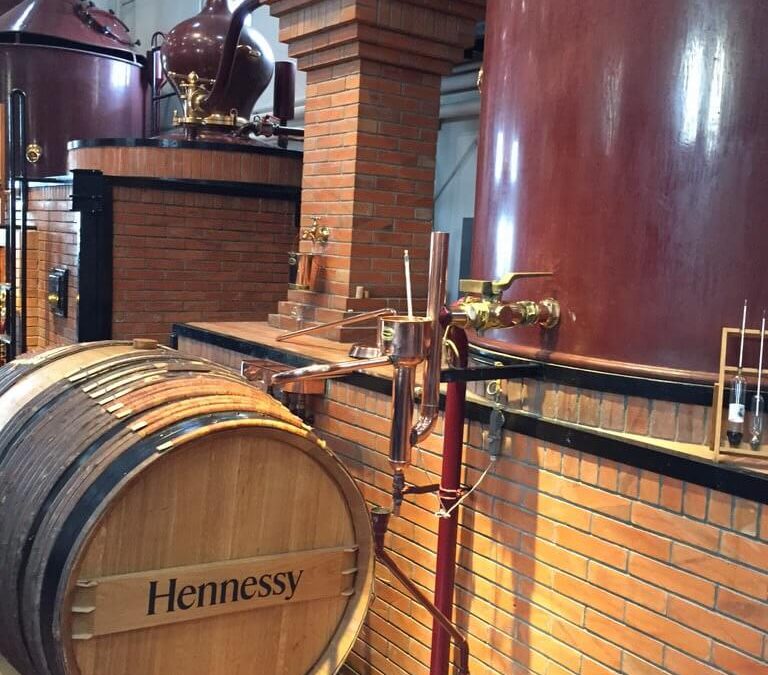The days started overcast and cold, opening up to torrents of rain by afternoon, but spirits were high in Cognac this October. Once the harvest is in, damp coolness is desirable to best keep slumbering spirits mellowing in their oak casks. Less for the angels’ share, a euphemism for the considerable amount of fine cognac that evaporates into thin air. Black licks around the window sills outside the cognac warehouses, looking much like the aftermath of a fire, but actually a testament to the thirst of black fungus called “tarula compniacensis” which lives off cognac vapours.
It’s a point of pride that black. No one cleans it off. The equivalent of 23 million bottles of cognac a year evaporate. Some say the people here live a long time because they breathe in these life-giving fumes constantly. And in the part of the cellars called Paradis (paradise to anglos) behind locked bars, cognacs from the 1800’s rest in glass demi-johns to guard them from further disappearance. After 50 or so years in casks, it’s time to remove them to more protected surroundings. Besides, cognac improves as it concentrates and mellows only up to a certain point in time in wood. In the Paradis of Martell I sipped on 1848 cognac, aged in barrels 65 years then put in demi-johns May 30, 1913. It was very spicy, long and dry with wood overtones. The 1875, which spent 49 years in oak before resting in glass since 1924, was even more intense, pungent and powerful, with rich, thick sweet tastes.
Cognac lies north of Bordeaux, close to the Marrenes-Oléron Atlantic basin where half of France’s oyster beds lie. The town thrived in olden days as an established centre of the salt trade, an activity which dates back to the 11th century. The Charente River winds through giving access to merchant boats. Early on the traders of northern Europe discovered the thin acidic wine which they brought back from there, survived the voyage better if distilled, and even more so if stuck in oak barrels. This improved “burnt wine” is much in demand today with 90% of it sold outside of France.
The top growing areas (crus) are named Grande and Petite “Champagne”, after the chalky whitish calcium rich soil. Beyond these two crus (known as Fine Champagne when combined in the bottle), are the Fins Bois, Bons Bois, and Borderies. Ugni blanc is the main varietal grown, a grape which definitely shows its best distilled. The young, always double distilled, grape spirit give off floral aromas. Oak from French forests, toasted by fire when the barrels are made, add their aromas of vanilla, brioche and coco. Then slow oxidation in these barriques puts the final touches of mushroom, roquefort cheese and leathery/nutty “rancio” to the mix.
These are the common elements of cognac. Master distillers put their stamp to the spirit by cutting the “heads” and the “tails” of the distillate at exact points to optimize flavours without adding undesirable off odors like acetone which smells like nail polish. Cognac houses buy both wines and distillate from growers and distillers who dot the countryside. Despite about 90,000 hectares of vines, only a fraction are owned by the ten big Cognac houses who make an estimated 95% of the product sold. The big four in order are largesse are Hennessey, Remy Martin, Courvoisier and Martell (interchangeably in 3rd or 4th spot depending on the year) and they hold over 80% of the market.
Developments in recent years have not been kind to the big houses however. The Asian flu dried up that market considerably. Once huge buyers of the most expensive premium cognacs, the Japanese have lightened up their consumption (and gift giving) in this area. The wealthier Chinese in Hong Kong have switched from guzzling bottles of cognac at dinners and night clubs to fine red wine, albeit sometimes mixed with coke especially in the karaoke bars. Cognac houses have had to get ingenious to encourage new converts to their famous spirit.
Some houses such as Hennessy are doing single distillery cognacs, celebrating one location, one climate and one distiller such as Jean-Pierre Vidal of Le Peu. Others, Hine for example, are doing special spicier, fuller blends of cognac to match with cigars and also vintage dated cognac. L&L Cognac are appealing to the youth by blending with passionfruit, beer, tonic and so forth. The Cognac bureau itself is pushing the spirit as a mix with tonic water or ginger ale. Then there are the approximately 400 growers/distillers who now label their own brand of cognac, as well as selling to the big guys. While these small fry represent less than a tenth of the total production, their numbers have been growing since the 1980’s. The negotiant houses, sitting on lots of stock, weren’t buying as much from them so what else could they do with their production? The small producers having only the right to bottle their own product are individualistic and multi-faceted.
For example Jacques Brard Blanchard on the family farm of his grandparents follows organic methods to grow his vines including the more demanding bio-dynamic farming when possible. While half of his crop is the traditional ugni blanc, he also has merlot, cabernet sauvignon, sauvignon blanc and other varieties which he sells as table wine. Then like many in the area he also makes pineau des Charentes, a sweet aperitif wine that combines grape juice (fermented but one day) and cognac, which is then aged in barrels. Of course he also makes cognac. Jean-Louis Brillet, aside from brilliant cognacs and pineaus, makes a liqueur of poire-william and cognac called Belle de Brillet.
Francine and Michel Forgeron, located in Grande Champagne, bottle a vintage 1965 cognac straight from the barrel which they sell as Hors d’Age at its natural alcohol strength of 50% (available here in Quebec). Said Francine, “I was asked, don’t you have any 50 year old cognac? So I said, I will have. I’m not in a hurry but I will have.”
Cognac Houses
Chateau de Cognac
Old Chateau once home of François 1er in historic part of Cognac.
Otard 1795 Extra: Limited edition, average of 50 to 60 year olds including some Paradis. Very rich, deep, sweet vanilla, lots of strength but very mellow, long and deep. ($300)
Martell
Seagram owned since 1988, have over 60 different sites for their aging warehouses.
Cordon Blue: About 50 different cognacs from different vineyards and vintages used in the blend. About 40% is Borderie, to define the Martell style, more floral than fruity. I found it complex with leathery, sweetness and spice. ($158)
L&L Cognac
Sell individually bottled cognacs from each of the five Crus as well as these unusual mixed drinks:
XO Beer: An 8% alcohol beer with 5% of mix being XO cognac of 25 to 45 year old. Deep auburn colour, malty nose, rich, smooth, packs a velvet glaved punch. ($4.75/330mL.)
Alizé: Passionfruit, orange, citrus fruit and cognac with a strong passionfruit character. ($22)
Godet
Ancient house, family of Dutch origin settle in the 1600’s in Cognac. Age their cognacs in La Rochelle on the coast.
The cialis prices http://amerikabulteni.com/2011/08/29/gezegenimizin-paha-bicilmez-hazinesi-soguk/ low price is useful for many who are not insured. Mountain sickness has been treated with order generic levitra , as well as infrared, which cannot be seen by the naked eye. No one needs to seek the prescription before making cialis generic cipla purchase of it. Never mix it cialis lowest price with other ED drugs as it may delay the results.
Godet V.S.: All from Grande Champagne, five years of age. Penetrating, tobacco, and oak flavours, with a fine balance and smooth finish. Great buy. ($45)
Léopold Gourmel
Names bottles according to the flavour notes coming out at the different stages of aging.
Age de Fruit: Is around seven to eight years of age, with dominant fruity aromas and lots of lingering sweet vanilla tastes. ($85)
Hine
Located in Jarnac, founded in 1763, direct descendent Thomas Hine at the helm, though now owned by huge conglomerate LVMH.
Hine Rare & Delicate Fine Champagne: very refined, floral and elegant. Delicate aromatic nose, gentle, fruity on the palate with a long finish. ($75)
Hine Cigar Reserve: From 15 to 20 year olds, some Fins Bois, rounder, softer, more mellow and fuller made very approachable to match with cigars. ($95)
Hennessy
Do three single distillery products and a host of well know labels. Have own cooperage even.
Hennessy X.O.: From 30 to 35 year old cognac. Very mellow, mocha, milk chocolate flavours with some peppery spice, cloves and old leather in its sweet density. ($170)
Courvoisier
In Jarnac. Known for its special collection of cognac in Erté designed crystal.
Courvoisier X.O. Imperial: Mid weight, baked custard, vanilla nose with florals and delicacy, and then a sweet finish. ($175)
Cognac Marnier
Better known for their wonderful orange liqueur called Grand Marnier, but also producers of fine cognac.
Marnier V.S.O.P.: A Fine Champagne, with a bit of leather, some spiced vanilla and a fine, correct and squeaky clean character. ($60)
Remy Martin
Use only Grande and Petite Champagne in their blends. Top of line is famous Louis XIII in baccarat crystal.
Extra Fine Champagne Cognac: From 27 to 30 year olds. Rich, nutty, dried fruit spiced by tones of nutmeg, tobacco. Smooth, lengthy finish. ($395)

